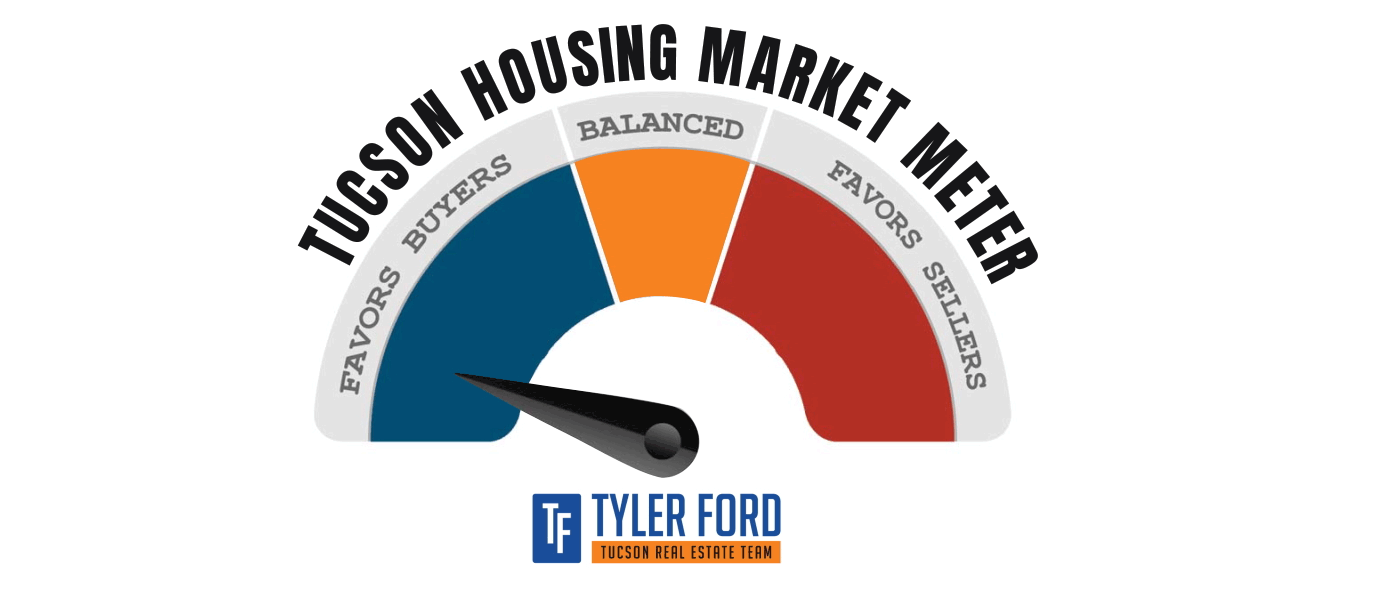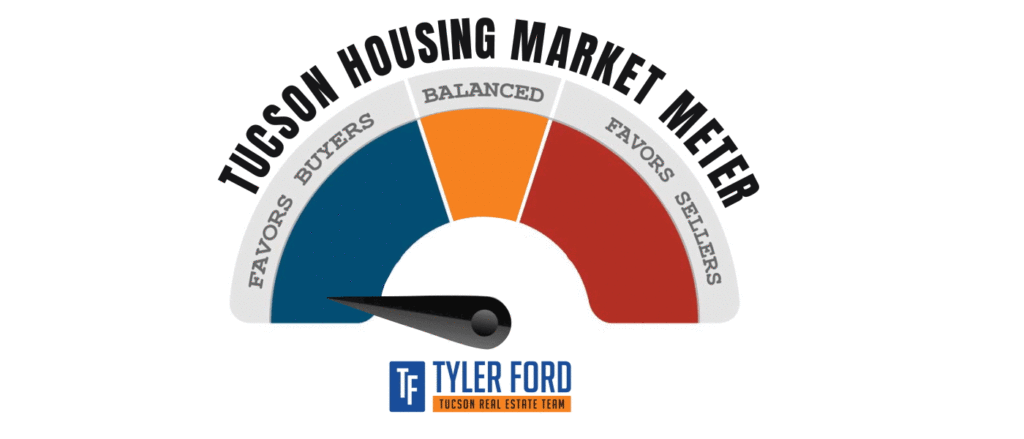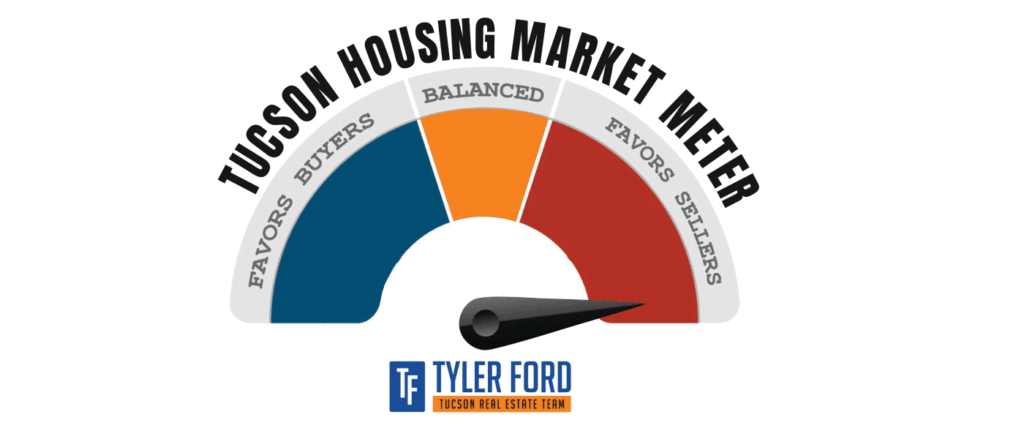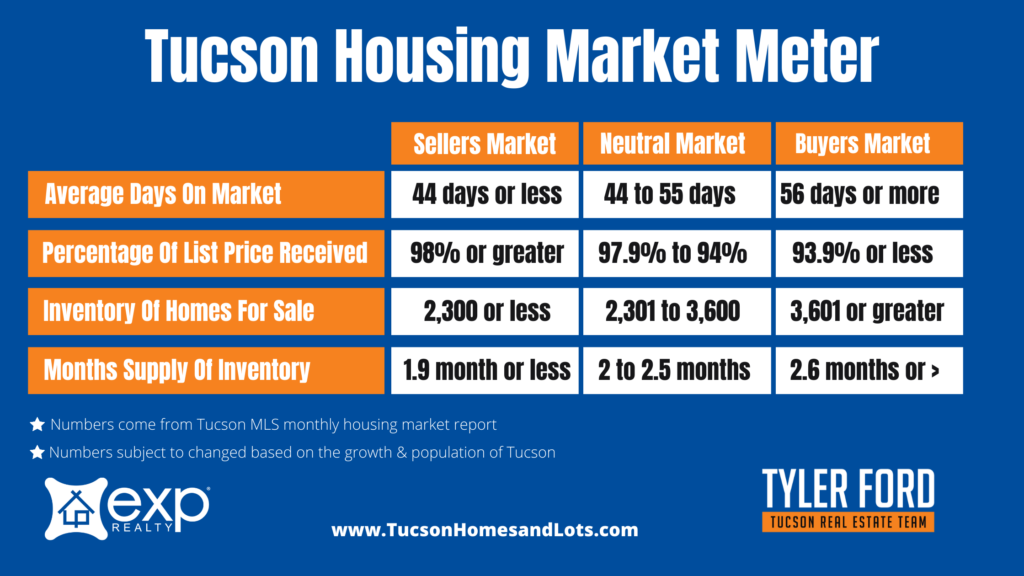How To Determine If Tucson Housing Market Is A Sellers, Buyers or Neutral Market?
Tucson Housing Market Meter... How To Determine Tucson's Housing Market
How to determine what kind of housing market we’re in, in Tucson, Arizona.
Is the Tucson housing market in a seller’s market, a buyer’s market or a neutral housing market here in Tucson, Arizona.
The video above explains the Tucson Housing Market Meter and how to determine what type of housing market we’re in, in Tucson, Arizona?
Foundation For Tucson Housing Market
Before going into various types of markets, whether we’re in a seller’s market, buyer’s market, or a neutral’s market, I want to lay a foundation for some basic understanding of a few things.
The first thing that a lot of people may or may not know is regardless of the market that we’re in, homes are still bought and sold. Typically, on average, regardless of the market that we’re in, there’s anywhere from 1000 homes up to 14 to 1500 home transactions each and every month. Homes are still bought and sold regardless of the market that we’re in. The second thing I want to talk about is typically, in any market, the first 30 days of a home being listed for sale is the telling story of your listing.
Within 30 days, if you’re not getting a lot of activity and you’ve not received any offers, it typically means one of a couple different things. But the first and most important thing, typically, within the first 30 days, if you’re not happy with the traffic and/or haven’t received any offers, it’s usually a matter of price. It means your home is not priced correctly out of the gate. The mistake that a lot of sellers make is they overprice their home and that can be a detriment to the listing because the longer it sits on the market, people begin to ask, “What’s wrong with this property?” It’s really important upfront to list your home correctly, and again, within the first 30 days if you’re not getting activity and/or offers, it typically means that it’s not priced right.
Sometimes the home could be listed incorrectly and it does happen towards not showing up correctly on the various searches. So just want to lay that foundation for homes are still bought and sold regardless of the market, and within the first 30 days if you’re not getting the activity that you thought you would get, it’s usually a matter of pricing.
You need to go back to the listing, revisit it and have a game plan in place in terms of your pricing strategy when listing a home.
Before I dive into how to determine whether we’re in a seller’s market, buyer’s market or a neutral market, I want to explain the indicators that I’m going to use in order to determine what market we’re in. Each and every month, TAR, the Tucson Association, puts out their monthly market report statistics of a lot of really, really good information to help you better understand the Tucson Housing Market that we’re in.
Tucson Housing Market Meter 4 Indicators
There are four indicators I like to use to help determine and explain what kind of market we’re in. I’m going to explain the four that I’m going to talk about.
The first one is what we call average days on market, and that is how long does it take a home from the time that it’s listed until the time that it goes under contract, which determines what type of market we’re in.
The next one I’m going to talk about is what we call percentage of list received, and that is when somebody lists a home, what’s the final sales price percentage based on the actual list price. The closer the sales price is to that list price can determine what type of market and/or exceeding percentage of list. As of this recording, right now the percentage of list is over 100%, which means we’re in a seller’s market.
The next one I want to talk about, this is my favorite, it’s inventory of homes for sale. So how much inventory is on the market? It’s economics 101, supply and demand. With less inventory, it’s typically a seller’s market. It drives prices up, and the more inventory that floods the market, that puts us more in a buyer’s market because there’s just a lot of homes to choose from and homes sit on the market longer. So buyers are in the driver’s seat when there’s more inventory, sellers are in the driver’s seat when there’s less inventory.
The last one, this goes with inventory home for sale and then how fast homes are actually selling, and that is months supply of inventory. That number means how long, if no other homes hit the MLS today, how long would it take for the entire inventory, properties listed in the MLS, how long would it take for everything to be sold? That’s what we call months supply.
Those are the four of that I’m going to use when I go through each of the various how to determine whether we’re in a seller’s market, buyer’s market, or a neutral market? Just so you have a good understanding of those numbers. As of this recording, we are in a seller’s market, and we’ve been in a seller’s market for quite some time here in Tucson. We’ve had a long run here in Arizona and even across the country as far as many places being in a seller’s market. It has everything to do with supply and demand, and when COVID hit, inventory levels dropped even further which then created… we had a ton of demand coming in. We had a drop in inventory, which has created upward pressure on prices.
How To Determine A Sellers Market in Tucson

As of this recording, we’re in a seller’s market. I’m going to go over, in my opinion, what determines a seller’s market.
The first one I want to talk about is average days on market, how long does it take a home to sell from time listed to the time under contract? I would say 44 days or less would be a seller’s market, in my opinion. When homes are selling 44 days or less, it’s typically a seller’s market here in Tucson, Arizona.
Percentage of list, that is what are people getting based on their list price, the percentage of it. In my opinion, a seller’s market percentage of list, sellers are getting 98% or more of their list price which would determine, in my opinion, being in a seller’s market.
Then inventory, that’s how much inventory there is listed in the MLS. I would say 2,300 listings or less is a seller’s market where we have less inventory than we do demand, which is going to put pressure on prices going up. And having sellers getting multiple offers and you having to compete as a buyer against other people, and it just being a very competitive market. 2,300 active listings or less, in my opinion, would determine that we’re in a seller’s market.
The last number is month supply of inventory, and that is how much inventory is listed in the MLS? If no more homes hit the MLS, how long would it take that inventory to be wiped out?
I would say month supply of inventory, 1.9 months, so a little under two months of inventory would determine that we are in a seller’s market. Again, some of these are not going to be exact, but again, this is just my overall feeling of watching this market and being a licensed agent over 30 years.
Seeing Tucson evolve and grow, the numbers are going to change a little bit based on the population and the growth of Tucson. But, to me, that would determine a seller’s market in Tucson in regards to the Tucson Housing Market for a seller’s market.
How To Determine A Neutral Market in Tucson

Now let’s go over what I feel is a neutral market in Tucson, Arizona in regards to the Tucson Housing Market Meter. In a neutral market, there’s equilibrium of supply in demand. There’s an equal amount of people wanting to sell, an equal amount of buyers buying, and it creates more of a level playing field for both buyers and sellers.
What determines a neutral market, in my opinion, average days on market, anywhere from 44 to 55 days, in my opinion, would be a neutral market.
The percentage of list received in a neutral market is anywhere from about 97.9% downwards to 94% of percentage of list received, which would create a neutral market here in Tucson.
And then homes listed for sale, the inventory levels, in my opinion, anywhere from about 2,301 upwards to about 3,600 active listings in the MLS would create a neutral market.
Then, again, months supply of inventory creating a neutral market is anywhere from 2.0 to 2.5 months of inventory. Meaning that if no other homes hit the market today, that inventory would be sold off in two to two and a half months, which would create a neutral market housing market here in Tucson, Arizona.
How To Determine A Buyers Market in Tucson

So now let’s go over a buyer’s market, and it’s been quite some time since we’ve seen a buyer’s market here in Tucson, Arizona. Back in 2007, 2008, when the housing market melted down, we were in a buyer’s market and that lasted until probably 2011, maybe 2012 when the housing market started to turn around.
There were about four or five years of our market being a buyer’s market, and in a buyer’s market, it creates a place where buyers can get a lot of different things. They can get seller concessions, they get a lot more repairs done on the BINSR, which is the inspection period, the buyer inspection noticed a seller response.
Basically, buyers are in the driver’s seat in terms of seller concession repairs and just getting various things from the sellers because sellers are having a more difficult time selling their property.
The first number I want to talk about is average days on market. If you think about this, it’s more of a psychological thing that it’s just human nature. After a period of time, people begin to get impatient. When that happens, they start to do price reductions, and there’s a lot of times when sellers have to sell a house. Whether it’s financially not able to make payments or a change in lifestyle, a change in a job to where they’ve got to get something sold.
When a home sits on the market for a period of time, they’re more likely to do various things. From a psychological standpoint, average days on market, in my opinion, 56 days or more, but when you start to get into two months or so is when you notice the sellers are willing to give into more of the buyer’s demands.
The next number I want to talk about is percentage of list received. In a buyer’s market, I would say 93.9% or less of the percentage of list, in my opinion, would signify more of a buyer’s market.
The next number is inventory of homes for sale listed in the MLS, and I would say 3,601 or more would be a buyer’s market.
Back in 2007, ’08, when the market melted down, inventory levels started to exceed over 10,000 active listings in the MLS, and people were getting really, really good deals. I don’t know that we’re ever going to see that again, but there was just a ton of inventory and days on market was much higher. I would say 3,601 in terms of active listings here in the MLS would start to push us into more of a buyer’s market.
The last number is months supply of inventory. In my opinion, about 2.6 months or more of inventory listed in the MLS would give buyers more of a driver’s seat in terms of getting things from sellers.
These are just my opinions based on my gut feeling and watching this market and the numbers are going to be pretty accurate. But, again, they can change based on what’s going on here in Tucson in terms of whether we’ve got an expanding population or a declining population, things can change slightly.
To sum up the Tucson Housing Market Meter, and whether we’re in a seller’s market, neutral market, or a buyer’s market, I’m going see the chart below.

Questions About Tucson Housing Market?... We would love to help!
If you have any questions in regards to the Tucson Housing Market, you can reach out to us and myself or somebody on would be more than happy to answer any of your questions.
It depends on what side of the fence you’re on, whether you’re a buyer or a seller, or a lot of times, you’re both, you’re selling and buying. That can determine what you’re going to be doing in regards to the decisions that you are going to make. But the one thing I don’t have is a crystal ball, but all you can do is educate yourself and make really good decisions based on educating yourself in regards to the current market we’re in.
Again, if you have any questions, we are here to help.



